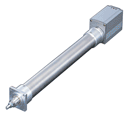Dear Friends.
I need a linear movement, where I, by using my plc, can tell how far this movement shall be.
What is a cheap solution for this ?
I was earlier thinking of using a Smartmotor and attach it with some kind of linear motion, but this would cost me a fortune.
Is’nt it possible to make this motion control easier ?
Best regards
laura
I need a linear movement, where I, by using my plc, can tell how far this movement shall be.
What is a cheap solution for this ?
I was earlier thinking of using a Smartmotor and attach it with some kind of linear motion, but this would cost me a fortune.
Is’nt it possible to make this motion control easier ?
Best regards
laura





